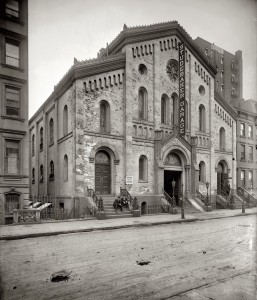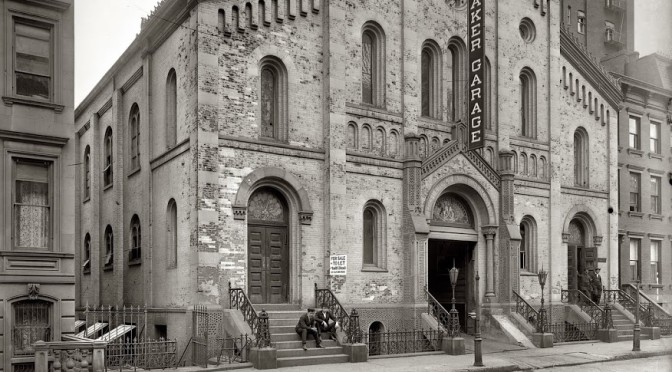
Drive-in salvation: the former All Souls church welcomed automobiles into the fold in 1908. (Courtesy Shorpy)
Another story of a long-gone, forgotten building and one that would have celebrated its dedication 150 years ago this week. This time the story has a strangely sacreligious twist!
It’s safe to say that most Americans were extremely anxious in April 1861. Even as a new president Abraham Lincoln settled into office, most of the Southern states had already seceded from the Union. One week later would begin the battle of Fort Sumter, commensing what would become the Civil War.
In a city of competing loyalties between its country and its rich Southern allies, it would have been difficult to get anything done in New York without lively debate on the matter. Newspaper were consumed with war talk. Irish and German workers excavating Central Park argued with each other about it; society was abuzz, from the Gramercy Park mansion of George Templeton Strong (a proponent for the Union) to the corridors of City Hall and the office of Mayor Fernando Wood (who was very much sympathetic to the South).
War consumed conversation; many New Yorkers feared the future. With everything going on, how can you possibly focus on anything else?
It was in this light, 150 years ago, that a simple little church, a Gothic brownstone structure of red and white brick, was dedicated on West 48th Street between Sixth and Seventh avenues. The All Souls Episcopal Church was nothing particularly fancy, “there were several oriel and oblong windows, not differing from those in churches generally,” the Daily Tribune said frankly.
All Souls would not have been terribly lonely in 1861, but West 48th Street was far from populated. Theaters wouldn’t make it up this far for decades, and nearby Long Acre Square was only now beginning to conjure the horse and buggy industries that would make its late 19th century reputation. Over on Fifth Avenue sat the new campus of Columbia College, its classrooms escaping the growing business district of lower Manhattan.
The congregants had much to pray about in its first years. Those competing loyalties and a conscription lottery that many thought targeted the city’s poor led to riots during the summer of 1863. Angry mobs stormed Columbia College and some nearby factories and residences, but All Souls was spared. Other Episcopal churches weren’t so lucky. (Harlem’s St. Philip’s, for instance was used as a barracks for police and Union soldiers fending off the rioters.)
All Souls survived the war and by the 1870s brandished a new name, the Memorial Church of the Rev. Henry Anthon. Rev. Anthon was a beloved leader from St. Mark’s-On-The-Bowery, and the building on 48th must have been closely connected to that congregation by this time. By the 1880s, it was also known as a charitable ‘bread and beef house’, “for the relief of worthy poor people between Thirty-second and Fifty-ninth streets.”
In 1889, the building went Methodist. Then for a time, in 1896, the church became ‘rented quarters’ for the New York City Christian Science Institute, one of the first New York headquarters for the fledgling religious practice and formed by Augusta Stetson on the orders of the church’s leader Mary Baker Eddy.
According to a 1904 issue of Architectural Record, the former All Souls building “was acquired and radically changed in structure, only the walls being left undisturbed.”
The Christian Scientists eventually moved out to much fancier digs (designed by the renown Carrere & Hastings) on the Upper West Side. But stripping out the detail of old All Souls Church may have ultimately doomed the structure. For in its next incarnation, it became a garage .
The carriage-industry district of Long Acre Square briefly became home to many of New York’s first automobile dealerships at the start of the 20th century.
The Studebaker company was among the most successful. Its main factory and showroom was just down the street at 48th Street and Broadway in what would now be called Times Square. By 1904 it began selling ‘horseless carriages’ that ran on gasoline. In that same year, the Studebaker company bought the old church and turned the former house of worship into a garage for its new vehicles.
The picture at the top of this posting shows the state of the building in 1908. In not a single way has the building’s original purposes been obscured, as though the owners wanted to make their automobiles new objects of worship. I do wonder if more religiously sensitive people thought this new purpose to be a bit blasphemous. What’s worse than turning a church into a garage? Turning a church into a nightclub, then a shopping mall, perhaps.
The garage was torn down one hundred years ago in 1911 and turned into a small theater, reflecting once again the changes of the neighborhood. It too was demolished and replaced — appropriately, with a garage — for the McGraw Hill building.
Photo above courtesy Shorpy

